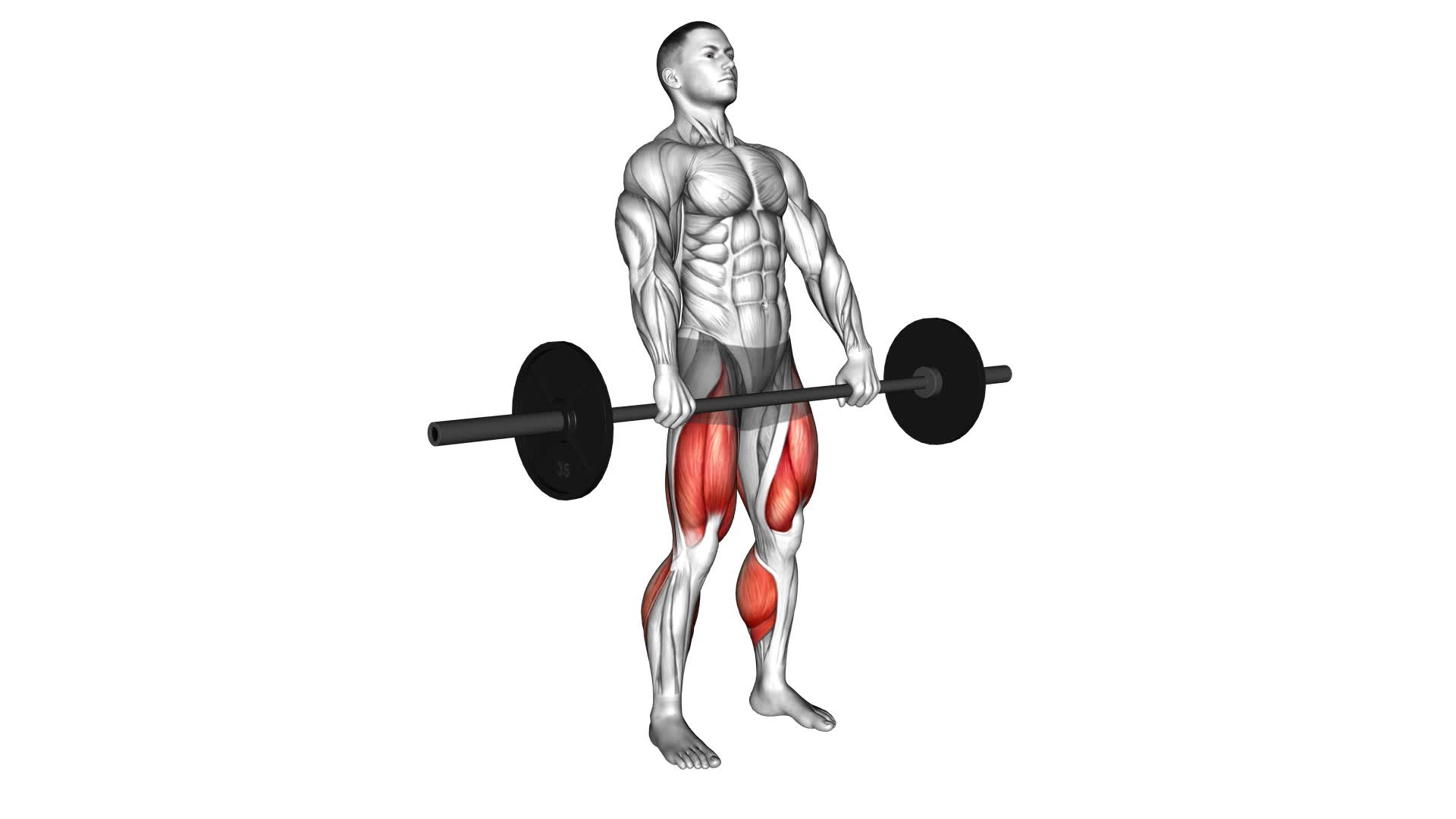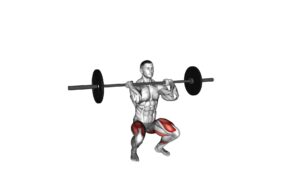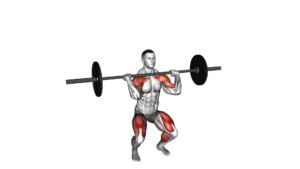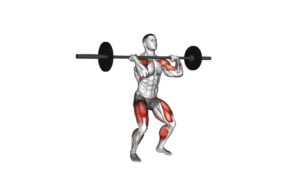Barbell Clean Deadlift – Video Exercise Guide & Tips

Are you looking to improve your deadlift technique and maximize your gains? Look no further than the Barbell Clean Deadlift!
Watch This Exercise Video
In this video exercise guide, we'll show you the proper set-up, key execution points, and common mistakes to avoid.
With helpful tips and variations, you'll be on your way to a stronger, injury-free deadlift.
So grab a barbell and get ready to lift with confidence!
Key Takeaways
- Proper set-up and grip are essential for optimal power transfer and to reduce the risk of injury.
- Keeping the barbell close to the body minimizes stress on the lower back and targets multiple muscle groups.
- Rounding the back, using too much weight, and not engaging the core properly are common mistakes to avoid.
- Progressions and variations can be used to increase load, target muscles differently, and improve balance and stability.
Proper Set-Up and Grip
To properly set up for the barbell clean deadlift, grip the barbell with both hands at shoulder-width distance. This is crucial for maintaining control and stability throughout the exercise. Many people make common grip mistakes when performing this movement, such as gripping the bar too wide or too narrow.
Gripping the bar too wide can put unnecessary strain on the shoulders and limit your range of motion. On the other hand, gripping the bar too narrow can make it difficult to maintain a strong grip and can increase the risk of the bar slipping out of your hands.
By gripping the bar at shoulder-width distance, you ensure a balanced and secure grip that allows for optimal power transfer from your legs and glutes. Additionally, proper set-up and grip have several benefits. It allows you to generate more force and power, leading to greater muscle activation and overall strength gains.
It also helps to improve your posture and alignment, reducing the risk of injury. By focusing on your grip and set-up, you lay the foundation for a successful barbell clean deadlift.
Key Points of Execution
Once you have established the proper set-up and grip, it's important to focus on the key points of execution for the barbell clean deadlift. Paying attention to these details will ensure that you perform the exercise correctly and maximize its benefits.
Here are some key points to keep in mind:
- Start with your feet hip-width apart and toes pointing slightly outward. This will provide a stable base for the lift.
- Engage your core by bracing your abs and squeezing your glutes. This will help maintain a neutral spine throughout the movement.
- As you lift the barbell, keep it close to your body. This will minimize stress on your lower back and maximize the activation of your posterior chain muscles, including your hamstrings and glutes.
By following these cues, you'll be able to perform the barbell clean deadlift with proper form and technique. This exercise targets multiple muscle groups, including your quads, hamstrings, glutes, and lower back. It also improves your strength, power, and explosiveness, making it a great exercise for athletes and anyone looking to improve their overall fitness.
Remember to start with lighter weights and gradually increase the load as you master the technique. Always prioritize safety and listen to your body throughout the exercise.
Common Mistakes to Avoid
Avoid these common mistakes when performing the barbell clean deadlift to ensure proper form and maximize results. One of the most common mistakes is rounding your back during the lift. This puts excessive strain on your spine and can lead to injury. To prevent this, focus on keeping your back flat and engaged throughout the movement.
Another mistake to avoid is using too much weight. While it's important to challenge yourself, using weights that are too heavy can compromise your form and increase the risk of injury. Start with a weight that allows you to maintain proper technique and gradually increase as you become stronger.
A common error isn't properly engaging your core. Your core muscles play a crucial role in stabilizing your body during the lift. Make sure to brace your core by contracting your abdominal muscles before initiating the lift.
Finally, rushing through the movement is another mistake to watch out for. Take your time and focus on each step of the lift to ensure proper technique and maximize the benefits of the exercise.
Progressions and Variations
As you progress in your barbell clean deadlift training, you can explore various progressions and variations to continue challenging your muscles and improving your strength and technique. Here are some advanced techniques and modifications for different skill levels that you can incorporate into your training:
- Double Clean Deadlift: Instead of lifting the barbell with one hand, try lifting it with both hands simultaneously. This will increase the load on your muscles and require greater coordination.
- Deficit Clean Deadlift: Place a platform or weight plates under your feet to elevate yourself. This will increase the range of motion and target your muscles in a different way, providing a unique challenge.
- Single Leg Clean Deadlift: Perform the clean deadlift while balancing on one leg. This variation not only works your posterior chain but also improves balance and stability.
By incorporating these progressions and variations into your barbell clean deadlift training, you can continue to challenge your muscles and improve your overall strength and technique. These advanced techniques and modifications cater to different skill levels, allowing you to tailor your training according to your abilities.
Now that you have explored different progressions and variations, let's move on to the next section where we'll discuss tips for maximizing gains and preventing injury.
Tips for Maximizing Gains and Preventing Injury
To maximize gains and prevent injury during your barbell clean deadlift training, focus on proper form and technique.
First and foremost, make sure to maintain a neutral spine throughout the movement. This means keeping your back straight and avoiding any rounding or arching. Engage your core and keep your shoulders pulled back and down to ensure proper alignment.
Additionally, it's crucial to start with an appropriate weight that allows you to perform the exercise with good form. Gradually increase the weight as you become more comfortable and confident in your technique.
Another key tip for maximizing gains and preventing injury is to use the correct grip. The barbell should be held with an overhand grip, with your hands slightly wider than shoulder-width apart. This grip will provide stability and control throughout the lift. It's also important to avoid using excessive momentum or jerking movements. Instead, focus on controlled and smooth lifts, using the power of your legs and hips to generate force.
Lastly, don't forget to warm up properly before each training session. This will help to increase blood flow, loosen up your muscles, and prepare your body for the demands of the exercise. Incorporate dynamic stretches and light cardio activities to warm up your entire body.
Frequently Asked Questions
How Many Sets and Reps Should Be Performed When Doing the Barbell Clean Deadlift?
When performing the barbell clean deadlift, it's important to consider the optimal training volume. This refers to the number of sets and reps you should do.
To determine this, you can start with 3-4 sets of 8-12 reps. However, keep in mind that everyone's fitness level and goals are different, so you may need to adjust accordingly.
Additionally, as you progress, you can increase the weight or try variations of the exercise to challenge yourself further.
What Muscles Does the Barbell Clean Deadlift Primarily Target?
The barbell clean deadlift primarily targets your glutes, hamstrings, and lower back muscles. It's a great exercise for building strength and power in your lower body. By incorporating this exercise into your routine, you'll experience a wide range of benefits, including improved muscle definition, increased explosive power, and enhanced athletic performance.
Additionally, there are variations of the barbell clean deadlift that you can try to target specific muscle groups and add variety to your workouts.
Can the Barbell Clean Deadlift Be Done With Dumbbells or Kettlebells Instead of a Barbell?
Yes, you can do the barbell clean deadlift with dumbbells or kettlebells instead of a barbell. This exercise allows for dumbbell substitutions and kettlebell variations.
By using dumbbells or kettlebells, you can still target the same muscles as the barbell clean deadlift, such as the glutes, hamstrings, and lower back.
Just make sure to maintain proper form and technique when performing the exercise with these alternative equipment options.
Is It Necessary to Use a Lifting Belt When Performing the Barbell Clean Deadlift?
When performing the barbell clean deadlift, you might wonder if using a lifting belt is necessary. While it isn't mandatory, using a lifting belt can offer several benefits.
It provides extra support to your lower back and core, helping to maintain proper form and reduce the risk of injury. The belt also helps increase intra-abdominal pressure, which can enhance your overall strength and stability during the lift.
Are There Any Modifications or Alternatives for Individuals With Limited Mobility or Injuries?
If you have limited mobility or injuries, there are modifications and alternative exercises that can be done instead of the barbell clean deadlift. These modifications can help accommodate your specific needs and allow you to still benefit from a similar movement pattern.
It's important to work with a qualified trainer or physical therapist who can assess your condition and provide appropriate modifications.
They may suggest exercises like kettlebell deadlifts, dumbbell deadlifts, or trap bar deadlifts as alternatives for limited mobility or injuries.
Conclusion
In conclusion, the barbell clean deadlift is a highly effective exercise for building strength and power in the lower body. By following the proper set-up and grip techniques, executing the movement with key points in mind, and avoiding common mistakes, you can maximize your gains and prevent injuries.
Additionally, incorporating progressions and variations, along with adhering to tips for maximizing gains, will further enhance the benefits of this exercise.
So, give it a try and enjoy the improvements in your overall fitness.

Author
Years ago, the spark of my life’s passion ignited in my mind the moment I stepped into the local gym for the first time. The inaugural bead of perspiration, the initial endeavor, the very first surge of endorphins, and a sense of pride that washed over me post-workout marked the beginning of my deep-seated interest in strength sports, fitness, and sports nutrition. This very curiosity blossomed rapidly into a profound fascination, propelling me to earn a Master’s degree in Physical Education from the Academy of Physical Education in Krakow, followed by a Sports Manager diploma from the Jagiellonian University. My journey of growth led me to gain more specialized qualifications, such as being a certified personal trainer with a focus on sports dietetics, a lifeguard, and an instructor for wellness and corrective gymnastics. Theoretical knowledge paired seamlessly with practical experience, reinforcing my belief that the transformation of individuals under my guidance was also a reflection of my personal growth. This belief holds true even today. Each day, I strive to push the boundaries and explore new realms. These realms gently elevate me to greater heights. The unique combination of passion for my field and the continuous quest for growth fuels my drive to break new ground.







